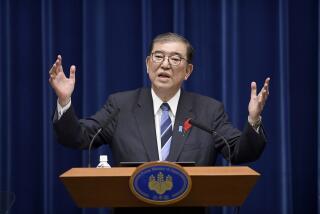Murayama Exit Expected to Spur Recovery
TOKYO — The resignation of Prime Minister Tomiichi Murayama on Friday, after 18 months of papering over divisions within Japan’s ideologically polarized ruling coalition, is likely to boost economic recovery in Japan.
Murayama’s departure paves the way for Liberal Democratic Party President Ryutaro Hashimoto, leader of the ruling group’s majority party, to ascend to Japan’s top post, perhaps as early as Thursday.
More important, Murayama’s exit brings Japan a step closer to a showdown between the outspoken Hashimoto and feisty opposition New Frontier Party leader Ichiro Ozawa--a faceoff some commentators have likened to a challenge between two mighty sumo champions. A general election is not required until next year, and Liberal Democratic Party Secretary-General Koichi Kato said Sunday that it would come in the autumn at the earliest.
Both men are staunchly pro-business, but their conceptions of how to get Japan’s economy back in gear after a five-year slump differ significantly. Hashimoto offers measured, step-by-step bureaucratic solutions, whereas Ozawa proposes a visionary economic overhaul that, if implemented, would amount to a kind of national shock treatment. Whatever happens, most analysts agree that Murayama’s departure is an important first step toward finding longer-term solutions.
“The situation couldn’t get worse. Even if I were elected, the stock market would go up,” said Haruo Shimada, an economics professor at Keio University. “Hashimoto knows a lot and is knowledgeable about the Ministry of International Trade and Industry, which will help. But Hashimoto is not going to bring too much visible change to economic policy.”
With news of Murayama’s resignation, the 225-stock Nikkei index rose moderately Friday, closing at 20,669.03, up 51.03 points, or 0.25%. But it gave up the gains in early trading today, falling 76, or 0.37%, to 20,592 in the first 15 minutes of trading.
Many analysts say that even before Murayama’s resignation, three essential prongs of recovery were already in place:
The central bank has embraced strong stimulative policies, with the interest rate at which it lends money to banks already cut to 0.5%. There is enough momentum in government spending to stimulate demand through the summer. And, after a year that witnessed an alarming rise in the strength of the yen, one that threatened to annihilate Japanese companies’ export profits, the exchange rate has at long last begun going in the right direction.
The dollar was trading this morning in Tokyo at 105.48 yen on the Tokyo foreign exchange market, compared with a post-World War II record dollar low of 79.75 yen, hit last April. A weaker yen makes Japanese exports more competitive and more profitable in yen terms.
“As far as economic policy, all the major hurdles have been cleared,” said Jesper Koll, an analyst at J.P. Morgan in Tokyo. “The economy is pretty much on autopilot until summertime.”
But it is the prospect of a general election, as well as of an Ozawa-Hashimoto showdown, that makes traders’ eyes glitter. The two men, with their clear policy objectives and politically aggressive styles, offer diverse recipes for change that could affect Japan’s economy not just for the next year, but for decades.
“It’s a bit like Gingrich and Dole,” Koll said, referring to the U.S. House speaker and Senate majority leader. “You have Ozawa as the Gingrich type, pushing for fast-track reform, and Hashimoto, like Dole, pushing for more moderate change.”
The two men are unified on the basics: Both are pro-business, and they express a commitment to a continued strong U.S.-Japan relationship, resolution of the banking system’s bad-loan problems and recovery of the Japanese economy.
But there are many other areas that scream for reform: Japan needs to reorganize its capital markets so that venture firms have a way to raise money through stocks. It must restructure its labor market and make its land market more open. Many economists and business people say that without an overhaul of the entire system, Japan’s most powerful companies will continue to move production overseas, further contributing to domestic unemployment.
Hashimoto is known as an economic conservative with close ties to the powerful government bureaucracy. Observers say Hashimoto, a onetime finance minister and now the international trade and industry minister, displays a grasp of detail that makes it easy for bureaucrats to work with him. That should have some economic benefits in the short term: He has vowed to make economic recovery a priority, and observers are predicting that he may opt to use public spending to stimulate the economy.
The visionary Ozawa, by contrast, proposes radical steps to set the economy on a new course: phasing out dying industries, tax reform that would include boosting the consumption tax to 10% from the current 3%, altering outdated land transaction taxes and pursuing rapid deregulation. Ozawa’s drastic measures threaten more pain for individuals, but advocates say they would make the economy healthier overall.
“Hashimoto knows the bureaucracy, so things on the surface will get better, but the underlying problems will continue to accumulate,” Shimada said. “But Ozawa has such good ideas and such determination for the long run. . . . He is what a politician should be--laying down the framework for nations.”
More to Read
Sign up for Essential California
The most important California stories and recommendations in your inbox every morning.
You may occasionally receive promotional content from the Los Angeles Times.










